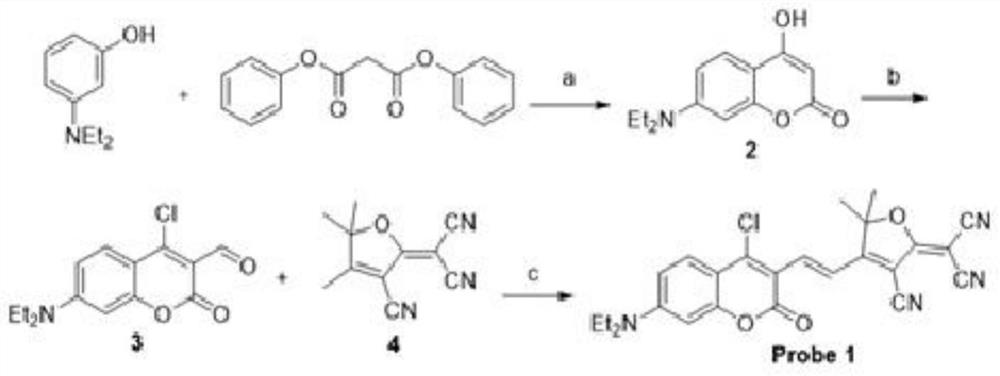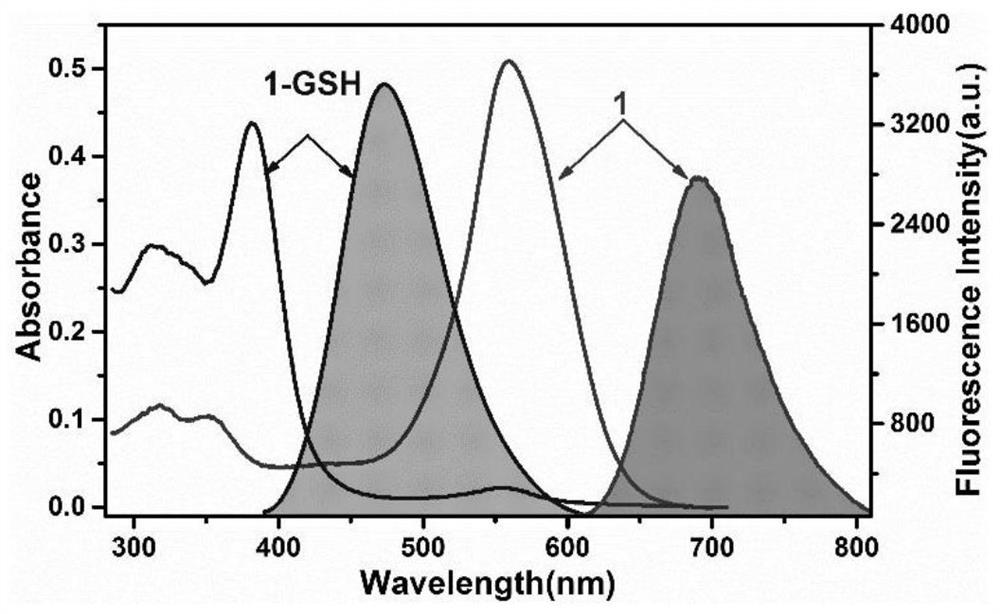A fluorescent probe for detecting intracellular glutathione and its preparation method and application
A technology of fluorescent probes and glutathione, which is applied in the direction of fluorescence/phosphorescence, chemical instruments and methods, and luminescent materials, can solve the problems of complex cell microenvironment, and achieve strong anti-interference ability, high safety, and good organization penetrating effect
- Summary
- Abstract
- Description
- Claims
- Application Information
AI Technical Summary
Problems solved by technology
Method used
Image
Examples
Embodiment 1
[0038] Embodiment 1: the synthesis of fluorescent probe
[0039] The synthesis process of fluorescent probe in the present invention is as follows figure 1 As shown, the specific process is as follows:
[0040] The first step, the synthesis of 7-(diethylamino)-4-hydroxyl-coumarin:
[0041] Add 3-(N,N-diethylamino)phenol (12.9g, 78.05mmol) to a solution of diphenyl malonate (20g, 78.05mmol) in toluene (80ml) and heat to reflux for 7h. After the reaction was completed, filter, and the filter cake obtained by filtering was washed with hexane, and vacuum-dried to give a light yellow solid (about 9.8g, 53.8%), 7-(diethylamino)-4-hydroxyl-coumarin, and The structural formula of the 7-(diethylamino)-4-hydroxy-coumarin is shown in formula (II).
[0042] Formula (Ⅱ)
[0043] The second step, the synthesis of 4-chloro-7-diethylaminocoumarin-3-aldehyde:
[0044] Under argon protection, freshly distilled DMF (N,N-dimethylformamide) (5.6 ml) was added dropwise to POCl at room temper...
Embodiment 2
[0051] Example 2: Detection of cytotoxicity by fluorescent probes
[0052] In this example, the effect of the fluorescent probe prepared in the above-mentioned Example 1 on macrophage Raw264.7 (purchased from Wuhan Typical Culture Collection Center, China, number: 3142C0001000000131), hepatocyte L-02 (purchased from Wuhan Typical Culture Collection, China) was explored. Collection Center, No.: 3142C0001000000077) and tumor cell BEL-7402 toxicity (China Wuhan Type Culture Collection, No.: 3142C0001000000035). Depend on Figure 5 As shown, under the action of the fluorescent probe concentration (0.625-5 μM) for 24 hours, the survival rates of the three types of cells were all above 90%, indicating that the fluorescent probes of the present invention are non-toxic and safe to cells.
Embodiment 3
[0053] Example 3: Responses of different concentrations of fluorescent probes to endogenous GSH
[0054] The fluorescent probe in the present invention emits two types of fluorescence, red and blue, wherein the red is the autofluorescence of the fluorescent probe, and the blue is the fluorescence after the reaction between the fluorescent probe and GSH. BEL-7402 cell slides were grown in 24-well plates, and when the cell fusion rate reached about 80%, different concentrations of fluorescent probes (0.625, 1.25, 2.5 and 5 μM) were added to act for 30 minutes. After the experiment, take pictures with a fluorescence microscope. The excitation wavelength of the blue channel is 405nm, and the emission wavelength is 430-490nm; the excitation wavelength of the red channel is 575nm, and the emission wavelength is 590-650nm.
[0055] Depend on Figure 6 As shown, where A-D are 0.625, 1, 2.5, 5 μM fluorescent probes for 30 min respectively, and the Scale bar is 50 μm. Depend on Figu...
PUM
 Login to View More
Login to View More Abstract
Description
Claims
Application Information
 Login to View More
Login to View More - R&D Engineer
- R&D Manager
- IP Professional
- Industry Leading Data Capabilities
- Powerful AI technology
- Patent DNA Extraction
Browse by: Latest US Patents, China's latest patents, Technical Efficacy Thesaurus, Application Domain, Technology Topic, Popular Technical Reports.
© 2024 PatSnap. All rights reserved.Legal|Privacy policy|Modern Slavery Act Transparency Statement|Sitemap|About US| Contact US: help@patsnap.com










